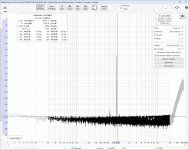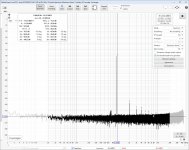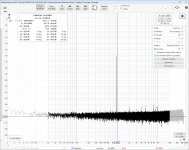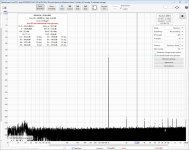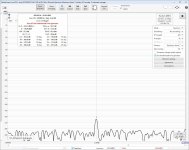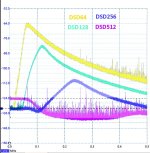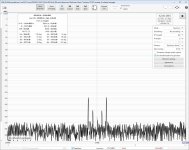Reversed means that
1110 1001
becomes after reversal
1001 0111
Hans
Of course, but... What is the time axis?
@TNT
Its not a rotation. It is a reversal.
https://www.browserling.com/tools/reverse-binary
https://onlinetoolz.net/bitshift#base=2&value=0&bits=8&steps=1&dir=r&type=log&allsteps=1
Its not a rotation. It is a reversal.
https://www.browserling.com/tools/reverse-binary
https://onlinetoolz.net/bitshift#base=2&value=0&bits=8&steps=1&dir=r&type=log&allsteps=1
I’ll come back with more accurate sims for DSD256 silence, now played with 88.6 nsec steps, with all further details.Of course, but... What is the time axis?
Hans
Impressive analysis.I've tried to work out my hypothesis about the out-of-band signals and the low-level distortion a bit further, see the attachment. I still can't exactly explain why the distortion products occur where they occur.
I’ll try to see whether any of this can be detected in a simulation.
If so, changing the filter topology could give more insight.
Hans
Hans, the spectrum plots you showed last night didn't show any noise shaping at low frequencies. Depending on what you simulated, that could be due to DAC imperfections or due to simulation inaccuracies.
I wonder if this weird modulation problem could be the cause why I preferred the sound of the Solid State Dac above the RTZ Firdac ?
Hans
Hans
Yes true, because that was only a very short time window, so I will need at least a 1 second window to get a 1Hz resolution.Hans, the spectrum plots you showed last night didn't show any noise shaping at low frequencies. Depending on what you simulated, that could be due to DAC imperfections or due to simulation inaccuracies.
Will be quite a challenge 😊
The other thing is that I’m using .dsf files converted by JRiver from PCM.
Will they produce the same anomalies as Bohrok’s PCMtoDSD converter ???
Hans
@bohrok
Did you also have these low level artefacts at DSD64 ?
I’m asking because creating a large time window in DSD256 will exceed by far the borders of what’s possible in my simulation.
I can maximally achieve a 0.35 second window in DSD64 in one go, that’s the equivalent of 1Mio samples.
Eventually I could possibly concatenate three of those windows if needed.
Hans
Did you also have these low level artefacts at DSD64 ?
I’m asking because creating a large time window in DSD256 will exceed by far the borders of what’s possible in my simulation.
I can maximally achieve a 0.35 second window in DSD64 in one go, that’s the equivalent of 1Mio samples.
Eventually I could possibly concatenate three of those windows if needed.
Hans
Yes true, because that was only a very short time window, so I will need at least a 1 second window to get a 1Hz resolution.
Will be quite a challenge 😊
The other thing is that I’m using .dsf files converted by JRiver from PCM.
Will they produce the same anomalies as Bohrok’s PCMtoDSD converter ???
Hans
That 300 Hz or so resolution should be quite sufficient to see the noise shaping curve in the audio band. If I were you, I would first simulate an ideal DAC with ideal filter and tweak the reltol, maximum time step and DFT settings until I saw a noise shaping curve, and then think about longer time windows for bohrok2610's low-level artefacts.
I wonder if this weird modulation problem could be the cause why I preferred the sound of the Solid State Dac above the RTZ Firdac ?
Hans
Who knows? It must be better in this respect: two out of three modulator algorithms of the solid-state logic gate DAC are quasi-multibit, it has one extra order of passive filtering before the active part of the filter (constructed such that it spoils the virtual ground at low frequencies) and it uses FET op-amps.
Last edited:
@bohrok
Did you also have these low level artefacts at DSD64 ?
At a given signal frequency, to get the same modulation index at lower sample rates, you have to increase the signal level inversely proportionally to the sample rate. You could also keep the signal level constant and reduce its frequency (250 Hz, -60 dB).
Here are measurements of 1kHz -60dBFS at DSD64, DSD128 and DSD256. The output stage is the dual OPA1632 "hat" I used in my output stage shootout. All signals were generated from sox 1kHz -60dBFS 44k1 PCM using sox-dsd with sdm8 filter. Player was foobar2000.
The low level distortion artefacts are clearly depending on the used modulator but sox-dsd with sdm8 seems to work well. These results look quite satisfactory to me.
The splitted harmonic peaks of PCM2DSD is my main concern as PCM2DSD is by far the easiest and most economic way to use this RTZ dac. Performance is very good apart from the splitted peaks.
The low level distortion artefacts are clearly depending on the used modulator but sox-dsd with sdm8 seems to work well. These results look quite satisfactory to me.
The splitted harmonic peaks of PCM2DSD is my main concern as PCM2DSD is by far the easiest and most economic way to use this RTZ dac. Performance is very good apart from the splitted peaks.
Attachments
Duh... may bad. I was wrong. See that now.@TNT
Its not a rotation. It is a reversal.
https://www.browserling.com/tools/reverse-binary
https://onlinetoolz.net/bitshift#base=2&value=0&bits=8&steps=1&dir=r&type=log&allsteps=1
//
... odd operation... byte swap.. what does it arithmetically mean?
Last edited:
To verify that splitting of harmonic peaks only occurs with PCM2DSD+RTZ, here is PCM2DSD+AK4493 with coherent averaging to pull out harmonics. No splitted peaks as can be seen at 2kHz.
Attachments
Here is +-20Hz with PCM2DSD+RTZ.bohrok2610 give a larger span eg. +-20Hz
Attachments
- Home
- Source & Line
- Digital Line Level
- Return-to-zero shift register FIRDAC
